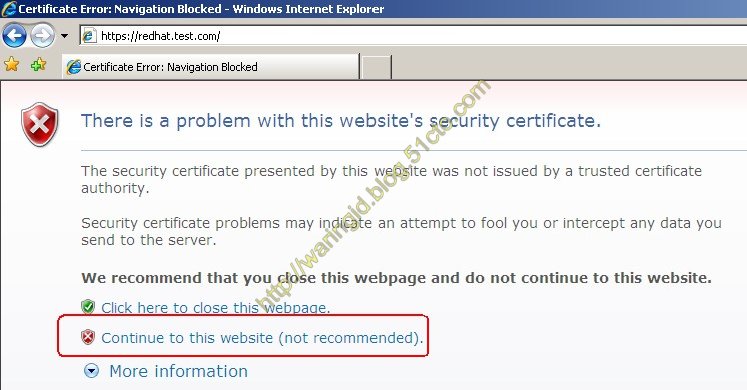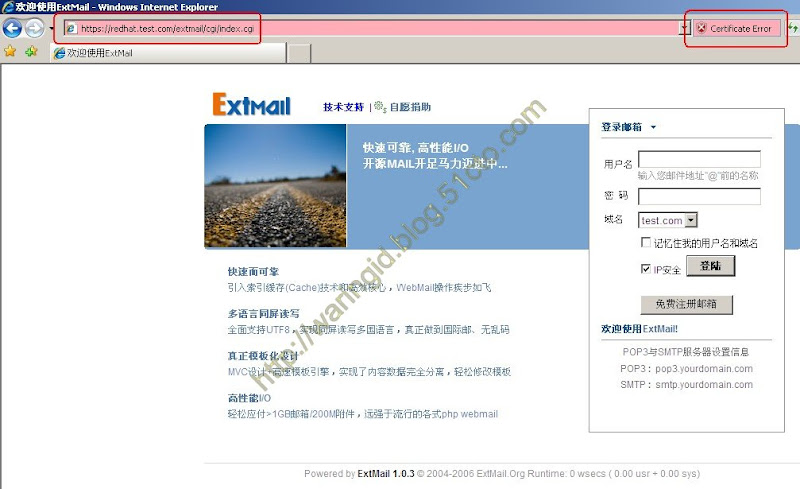在Windows下实现Web的安全访问很简单,只需要申请一张CA证书,然后在IIS中引用就可以实现目的了.其实在Linux下实现也不是很复杂.只要搞清楚步骤就很简单了.因为在局域网的环境中,所以不可能申请用于现实网络认证的证书,类似于windows,我们要先为自已建立根CA,然后利用根CA签发的证书来申请用于web服务的证书.这里通过OpenSSL来发行X.509 SSL Certificate.按 X.509 的规定,凭证可以用 RSA Key ,也可以用 DSA Key 。不过在 SSL 通讯中,伺服器的凭证因为要用来传 Key ,而只有 RSA 可以传 Key ,所以只能用 RSA 。至於认证中心,只是签名查核用,不用传 Key , DSA 或 RSA 都可以,但因为还有一些 SSL 程式不认得 DSA[2] ,为相容性起见,这里我们也做成 RSA 。
在这里假定用户已完成了Apache及OpenSSL的安装过程,如果对这些安装有困难的,可以参考这篇文章
[url]http://waringid.blog.51cto.com/65148/58144[/url]
.本文以完成postfix后,实现web的安全访问.
一:制作根CA
要制作最高层认证中心,可以以一般使用者权限来做,不一定要是 root 。但如果做出来的最高层认证中心,是整个组织签发凭证要用的,建议以 root 的权限来做,比较安全。同理,制作凭证,也可以以一般使用者权限来做。但如果做出来的凭证,是这个伺服器要用的,为安全起见,建议以 root 的权限来做.
1:设定相关目录
[root@redhat ~]# mkdir -pv /etc/ssl mkdir: created directory `/etc/ssl' [root@redhat ~]# mkdir -pv /etc/ssl/private mkdir: created directory `/etc/ssl/private' [root@redhat ~]# chmod og-rwx /etc/ssl/private/ [root@redhat ~]# mkdir -pv /etc/ssl/certs mkdir: created directory `/etc/ssl/certs' [root@redhat ~]# mkdir -pv /etc/ssl/crl mkdir: created directory `/etc/ssl/crl' [root@redhat ~]#mkdir -pv /etc/ssl/newcerts mkdir: created directory `/etc/ssl/newcerts'2:设定openssl配置文件
[root@redhat ~]# mv /usr/share/ssl/openssl.cnf /etc/ssl/ [root@redhat ~]# ln -sv /etc/ssl/openssl.cnf /usr/share/ssl/openssl.cnf create symbolic link `/usr/share/ssl/openssl.cnf' to `/etc/ssl/openssl.cnf' [root@redhat ~]# export OPENSSL_CONF="/etc/ssl/openssl.cnf" [root@redhat ~]# echo "# OpenSSL Setting Locate" >> ~/.bashrc [root@redhat ~]# echo "export OPENSSL_CONF=\"/etc/ssl/openssl.cnf\"" >> ~/.bashrc [root@redhat ~]# openssl rand -out /etc/ssl/private/.rand 1024 ##制作随机数 [root@redhat ~]# chmod og-rwx /etc/ssl/private/.rand [root@redhat ~]# vi /etc/ssl/openssl.cnf ##编辑配置文件 dir = /etc/ssl3:制作根CA的私钥
命令中
genrsa是表示生成rsa格式的私钥
,-des3是指使用的加密算法
;-out是指私钥的输出路径;
2048是指加密的位数.
[root@redhat ~]# openssl genrsa -des3 -out /etc/ssl/private/redhatroot.key 2048 Generating RSA private key, 2048 bit long modulus ..........+++ .....................................+++ e is 65537 (0x10001) Enter pass phrase for /etc/ssl/private/redhatroot.key: ##这里提示输入密码 Verifying - Enter pass phrase for /etc/ssl/private/redhatroot.key: [root@redhat ~]# chmod og-rwx /etc/ssl/private/redhatroot.key4:填写凭证申请书
凭证申请书,是把你的资料,和这个 Public Key 夹在一起,以便认证中心审核,签上签名用的。所以这个步骤,会问你这个 Key 的相关资料,包括国家、城市、单位名称、部门名称、凭证名称、联络人的信箱,以及申请的效期等等。请一一填写。
[root@redhat ~]# openssl req -new -key /etc/ssl/private/redhatroot.key -out /tmp/redhatroot.req Enter pass phrase for /etc/ssl/private/redhatroot.key: You are about to be asked to enter information that will be incorporated into your certificate request. What you are about to enter is what is called a Distinguished Name or a DN. There are quite a few fields but you can leave some blank For some fields there will be a default value, If you enter '.', the field will be left blank. ----- Country Name (2 letter code) [GB]:CN State or Province Name (full name) [Berkshire]:GD Locality Name (eg, city) [Newbury]:Dong Guan Organization Name (eg, company) [My Company Ltd]:none Organizational Unit Name (eg, section) []:redhat Common Name (eg, your name or your server's hostname) []:redhat Email Address []:[email]root@test.com[/email] Please enter the following 'extra' attributes to be sent with your certificate request A challenge password []: An optional company name []:5:签发凭证,创建根CA
根CA因为没有上级了,没有人能给它签名,只能自己给自己签名.根CA最好永远不要过期。要是过期重签,所有原来它签发的凭证也都要重签,所有 SSL 程式也都要重新设定。所以我们效期签 7305 天(大约 20年)。若不设效期的话,预设是 30 天(一个月)。redhatroot.crt 是公钥凭证,要尽量散出去,让大家用。最好放到内部网路上,或放到网站上,让大家自己下载,自己加进去。
[root@redhat ~]# openssl x509 -req -days 7305 -sha1 -extfile /etc/ssl/openssl.cnf \ -extensions v3_ca -signkey /etc/ssl/private/redhatroot.key -in /tmp/redhatroot.req \ -out /etc/ssl/certs/redhatroot.crt Signature ok subject=/C=CN/ST=GD/L=Dong Guan/O=none/OU=redhat/CN=redhat/emailAddress=test@test.com Getting Private key Enter pass phrase for /etc/ssl/private/redhatroot.key: [root@redhat ~]# rm -f /tmp/redhatroot.req##签完凭证,凭证申请书就不用了,可以删掉。二:创建web证书
1:生成证书私钥
[root@redhat ~]# openssl genrsa -out /etc/ssl/private/myhost.key 2048 Generating RSA private key, 2048 bit long modulus ..................+++ .............................................................................................................+++ e is 65537 (0x10001) [root@redhat ~]# chmod og-rwx /etc/ssl/private/myhost.key2:填写凭证申请书
被问及Common Name的时候,请输入你的web服务器的完全限定域名(FQDN)例如:redhat.test.com.当被问及A challenge password的时候,直接按回车继续。如果你没有在第二步从key中把passphrase删除,那么每次你运行/usr/local/httpd/apachectl start启动服务器的时候你都要输入密码。这也就意味着如果你的服务器因为某些原因重新启动了,除非你在服务器旁手动敲入了密码,否则你的web服务器就不会启动。
[root@redhat ~]# openssl req -new -key /etc/ssl/private/myhost.key -out /tmp/myhost.req You are about to be asked to enter information that will be incorporated into your certificate request. What you are about to enter is what is called a Distinguished Name or a DN. There are quite a few fields but you can leave some blank For some fields there will be a default value, If you enter '.', the field will be left blank. ----- Country Name (2 letter code) [GB]:CN State or Province Name (full name) [Berkshire]:GD Locality Name (eg, city) [Newbury]:Dong Guan Organization Name (eg, company) [My Company Ltd]:none Organizational Unit Name (eg, section) []:www Common Name (eg, your name or your server's hostname) []:redhat.test.com Email Address []:[email]root@test.com[/email] Please enter the following 'extra' attributes to be sent with your certificate request A challenge password []: ##这里不要输入密码 An optional company name []:3:生成web证书
[root@redhat ~]# openssl x509 -req -days 3650 -sha1 -extfile \ /etc/ssl/openssl.cnf -extensions v3_req -CA /etc/ssl/certs/redhatroot.crt \ -CAkey /etc/ssl/private/redhatroot.key -CAserial /etc/ssl/redhatroot.srl -CAcreateserial \ -in /tmp/myhost.req -out /etc/ssl/certs/myhost.crt Signature ok subject=/C=CN/ST=GD/L=Dong Guan/O=none/OU=www/CN=redhat.test.com/emailAddress=root@test.com Getting CA Private Key Enter pass phrase for /etc/ssl/private/redhatroot.key: [root@redhat ~]# rm -f /tmp/myhost.req三:配置Apache
1:编辑httpd.conf
编辑httpd.conf的内容以启用ssl支持,如果在安装apache时没有加载ssl模块,那么需要重新安装或编译.需启用LoadModule ssl_module modules/mod_ssl.so(第80行)及 Include /etc/httpd/extra/httpd-ssl.conf(第456行)
[root@redhat ~]# vi /etc/httpd/httpd.conf LoadModule ssl_module modules/mod_ssl.so ##启用这两行 Include /etc/httpd/extra/httpd-ssl.conf #<VirtualHost *:80> #ServerName redhat.test.com ##注释这几行,如果有的话 #DocumentRoot /var/www/extsuite/extmail/html/ #ScriptAlias /extmail/cgi /var/www/extsuite/extmail/cgi #Alias /extmail /var/www/extsuite/extmail/html #ScriptAlias /extman/cgi /var/www/extsuite/extman/cgi #Alias /extman /var/www/extsuite/extman/html #SuexecUserGroup vmail vmail #Alias /phpadmin /var/www/phpadmin #</VirtualHost>2:添加相关证书文件
[root@redhat ~]# cp /etc/ssl/certs/myhost.crt /etc/httpd/server.crt [root@redhat ~]# cp /etc/ssl/private/myhost.key /etc/httpd/server.key3:设置httpd-ssl.conf文件
对照修改以下的地方就可以了,重启后Apache就可以支持SSL了.
[root@redhat ~]# vi /etc/httpd/extra/httpd-ssl.conf <VirtualHost _default_:443> # General setup for the virtual host #DocumentRoot "/usr/local/httpd/htdocs" #ServerName [url]www.example.com:443[/url] #ServerAdmin [email]you@example.com[/email] ServerName redhat.test.com:443 DocumentRoot /var/www/extsuite/extmail/html/ ScriptAlias /extmail/cgi /var/www/extsuite/extmail/cgi Alias /extmail /var/www/extsuite/extmail/html ScriptAlias /extman/cgi /var/www/extsuite/extman/cgi Alias /extman /var/www/extsuite/extman/html SuexecUserGroup vmail vmail Alias /phpadmin /var/www/phpadmin ErrorLog /usr/local/httpd/logs/error_log TransferLog /usr/local/httpd/logs/access_log # SSL Engine Switch:4:重启服务
[root@redhat ~]# /usr/local/httpd/bin/apachectl stop [root@redhat ~]# /usr/local/httpd/bin/apachectl start四:测试

2:测试SSL功能是否可用

3:查看证书文件


4:证书的详细信息


























 713
713

 被折叠的 条评论
为什么被折叠?
被折叠的 条评论
为什么被折叠?








